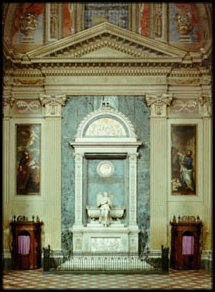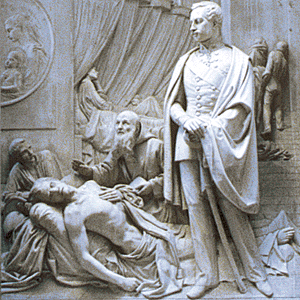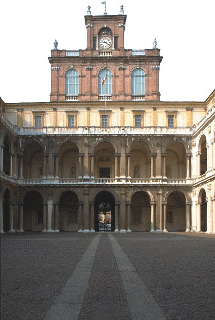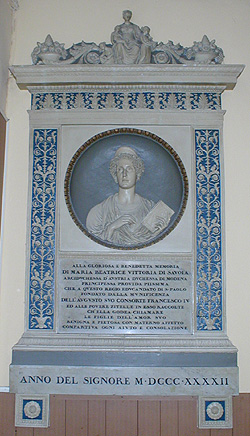 |
 |
 |
 |
 |
 |
 |
 |
 |
|
A Jacobite Gazetteer - Italy
Modena |
|
The city of Modena is located thirty-five kilometres north-west of the city of Bologna. For thirty-five years (from 1824 to 1859) the city was the main residence of the Royal Family. |
Chiesa di San VincenzoThis church is located at Corso Canalgrande, 75 (on the main north-south street on the east side of the city). The church contains a number of tombs of members of the Royal Family. 1 In the right transept is the funerary monument of Queen Mary III and II (died 1840) erected by her son King Francis I. It was designed by Adeodata Malatesta and sculpted in marble by Luigi Mainoni. 2 At the centre is an angel standing guard in front of the queen's sarcophagus. On the wall behind is a relief portrait of the queen in profile. In the arch above is a relief of God the Father. Below the sarcophagus is a relief showing the virtues Faith, Hope, and Charity. The monument is surrounded by a wrought-iron fence designed by Mainoni and executed by Giuseppe Cavani. There is a Latin inscription: 3 |
|
MEMORIAE ET VIRTVTI On the other side of the church, next to the pulpit, is the funerary monument of Prince Ferdinand (died 1849), younger son of Queen Mary III and II and father of Queen Mary IV and III. The monument, sculpted by Paolo Aleotti in 1859, 4 was originally placed in the Chiesa della Cittadella (closed in 1871).
The relief shows the Prince Ferdinand visiting the hospital where he contracted the cholera from which he died. A Latin inscription records the incident:
FERDINANDO KAROLO VICTORIO AVSTRIACO ATESTINO ARCHIDVCI AVSTR. |
|
From the sacristy (entrance in the right transept) one can gain access to the octagonal Cappella Funebre degli Estensi e degli Austro-Estensi. This funerary chapel was built in 1836 by Duke Francis IV of Modena (husband of Queen Mary III and II) for the mortal remains of his family and those of the Este dukes of Modena. Here are located the tombs of Queen Mary III and II (died 1840), her husband Duke Francis IV of Modena (died 1846), her younger son Prince Ferdinand (died 1849), and her granddaughter (only daughter of King Francis I) Princess Anna (died 1849).
The tomb of Queen Mary III and II is marked with the following Latin inscription:
HEIC CONDITA JACET The tomb of Duke Francis IV of Modena (husband of Queen Mary III and II) is marked with the following Latin inscription:
HEIC SITVS EST The tomb of Prince Ferdinand (younger son of Queen Mary III and II) is marked with the following Latin inscription:
A. P. O. The tomb of Princess Anna (only daughter of King Francis I) is marked with the following Latin inscription:
A. P. O. Also buried here are the parents of Queen Mary Beatrice (wife of King James II and VII): Duke Alfonso IV of Modena (died 1662) and his wife Duchess Laura Martinozzi (died 1687; her remains were moved here in 1925 from the former convent of the Salesians). In his will King Francis I left a bequest to the Church for five masses to be said for his soul each year. 5 Notes 1 Patrizia Belloi and Elis Colombini, Guida di Modena: manuale per l'uso storico artistico della città utile al modenese e al viaggiatore (Modena: Elis Colombini, 1992), http://www.colombinieditore.it/GdM/GdM.html. 2 Luigi Mainoni was born in Scandiano in 1804 and died in Modena in 1853. For over twenty years he was professor of sculpture at the Accademia Atestina di Belle Arti in Modena. 3 The text of this inscription and of the others in the Chiesa di San Vincenzo is taken from Alois Jahn, Die Grabstätten der Habsburger und der mit Ihnen Verwandten Häuser ausserhalb Österreichs, Das Haus Habsburg, Band II, Teil 3 (Privately printed, 2001). 4 Paolo Aleotti was born in 1813, and died in 1881. 5 Teodoro Bayard De Volo, Vita di Francesco V, Duca di Modena (l8l9-l875) (Modena : Tipografia dell' Imaculata Concezione, 1878). Image 1 (Monument to Queen Mary III and II): "Modena, Chiesa di San Vincenzo", http://www.cedoc.mo.it/fondazione-crmo/rest1.htm. Image 2 (Monument to Archduke Ferdinand): "Guida di Modena, Quartiere L, Immagini"" http://www.colombinieditore.it/GdM/QL/L_Images/076_IM_3.html. Image 3 (Cappella Funebre): "Modena, Chiesa di San Vincenzo", http://www.cedoc.mo.it/fondazione-crmo/rest1.htm. |
Palazzo dei MuseiThis palace, located in Largo Porta Sant' Agostino, houses several separate museums. The Museo Civico del Risorgimento contains portraits of Queen Mary III and II; her husband, Duke Francis IV of Modena; their son, King Francis I; and his wife, Queen Adelgunde. The museum is presently (2004) closed for renovations. The Galleria Estense was at one time the art collection belonging to King Francis I. In 1854 he opened it to the public, and in 1868 he gave it to the city of Modena. The gallery is open Tuesday, Friday, and Saturday 9:00 a.m. to 7:00 p.m.; Wednesday and Thursday 9:00 a.m. to 2:00 p.m.; Sunday 9:00 a.m. to 1:00 p.m.; closed Monday. |
Palazzo DucaleThe palace was the birth place of Queen Mary Beatrice (wife of King James II and VII). In 1717 their son, King James III and VIII, stayed here for three days (March 12 to March 14). 1 From 1814 until her death in 1840 the palace was the official residence of Queen Mary III and II and of her family. From 1840 until 1859 the palace was the official residence of her son King Francis I and his family. The palace is now a military academy. A guided tour (charge L10,000) is available every Sunday at 10.00 a.m. except for the month of August. A second guided tour on Sundays at 11.00 a.m. is only available if one has pre-booked with the Ufficio Accoglienza Turistica del Comune. Notes 1 Bryan Bevan, King James the Third of England: A Study of Kingship in Exile (London: Robert Hale, 1967), 98-99. |
Former Convento di San PaoloIn 1816 Princess Mary Beatrice (later Queen Mary III and II) founded a school for poor girls in the former convent attached to the Chiesa di San Paolo; the girls were known as the "Putte della Duchessa". 1 At the far end of the entrance hall on the ground floor of the convent is a terracotta memorial to Queen Mary erected in 1842 (two years after her death). At the top of the memorial is a sculpture of a mother with her three children flanked on either side by a cornucopia. Below a blue and white frieze of acanthus leaves is a round tondo which surrounds a slight recess containing a bust of Queen Mary. She is dressed as a Roman matron and holds a book (symbolic of education). On either side of the tondo is a blue and white panel decorated with arabesques. Below the bust of Queen Mary is an Italian inscription: |
|
This page is maintained by Noel S. McFerran (noel.mcferran@rogers.com) and was last updated July 14, 2005. |




